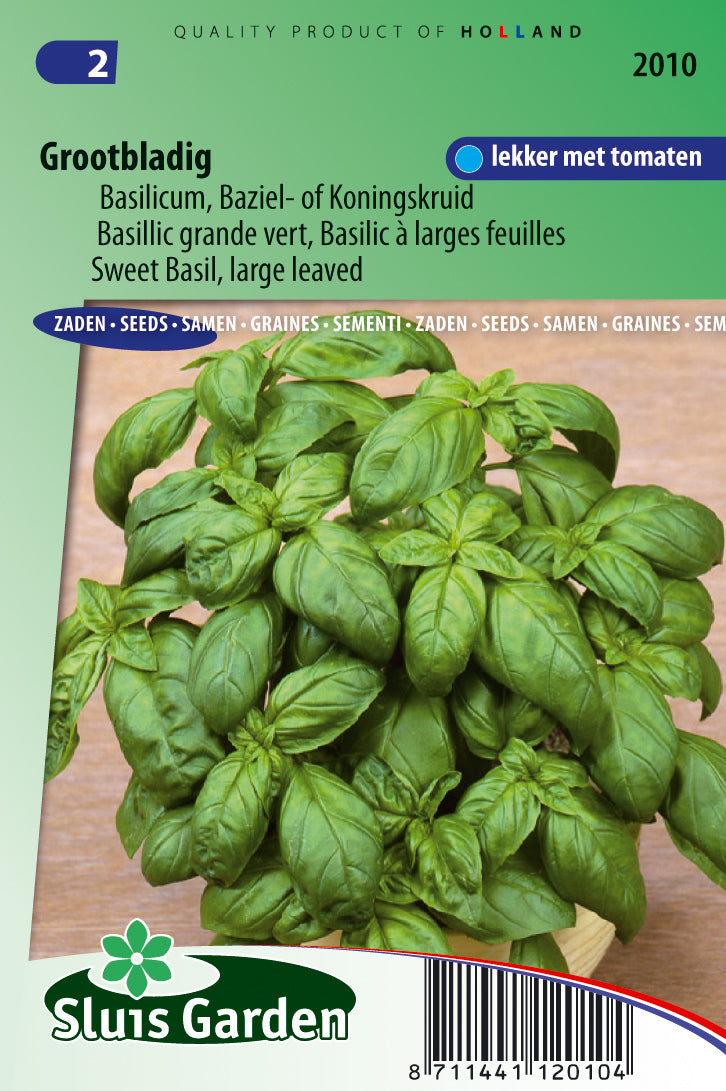1
/
of
1
Sweet Basil Large leaved Ocimum bas.
Sweet Basil Large leaved Ocimum bas.
Regular price
1.350 KWD
Regular price
Sale price
1.350 KWD
Unit price
/
per
Shipping calculated at checkout.
Couldn't load pickup availability
Growing Sweet Basil (Ocimum basilicum), especially the large-leaved variety, is a straightforward process. Here's a step-by-step guide to help you grow Sweet Basil Large-Leaved:
**1. Choose the Right Location:**
- Basil prefers a sunny location with at least 6-8 hours of direct sunlight per day. Ensure that the spot has well-draining soil.
**2. Soil Preparation:**
- Use well-draining, nutrient-rich soil with a slightly acidic to neutral pH (around 6.0 to 7.0). You can amend the soil with organic matter such as compost to improve fertility and drainage.
**3. Planting Seeds or Transplants:**
- You can start Sweet Basil Large-Leaved from seeds or purchase seedlings from a nursery. If planting seeds, sow them about 1/4 inch deep in the soil. If using transplants, plant them at the same depth as they were in their original containers.
**4. Spacing:**
- If planting multiple basil plants, space them about 12 to 18 inches apart to allow for proper air circulation and growth.
**5. Watering:**
- Keep the soil consistently moist, but not waterlogged. Basil prefers slightly moist conditions. Water when the top inch of soil feels dry. Ensure that the pot or planting area has good drainage.
**6. Fertilization:**
- Basil does not require heavy fertilization. You can apply a balanced, water-soluble fertilizer once a month during the growing season. Follow the package instructions for application rates.
**7. Pruning:**
- Pinch or prune the growing tips regularly to encourage bushier growth. This will also prevent the plant from flowering too early, as basil tends to lose some of its flavor once it starts flowering.
**8. Harvesting:**
- Harvest the leaves when the plant has reached a sufficient size. Harvesting encourages branching and promotes a fuller plant. Use clean scissors or pinch off the leaves, but avoid removing more than one-third of the plant at a time.
**9. Companion Planting:**
- Basil is known to be a good companion plant for certain vegetables, like tomatoes. Consider planting it alongside other compatible plants in your garden.
**10. Watch for Pests:**
- Keep an eye out for common basil pests such as aphids and spider mites. If you notice any pests, you can use insecticidal soap or neem oil as a natural remedy.
**11. Protect from Cold:**
- Basil is sensitive to cold temperatures. If frost is expected, cover the plants or bring potted basil indoors to protect them from cold damage.
**12. Propagation:**
- If you want to propagate Sweet Basil Large-Leaved, you can take cuttings and root them in water. Once roots develop, transplant the cuttings into pots or the garden.
Growing Sweet Basil Large-Leaved can provide you with abundant, aromatic leaves for culinary use. Enjoy the process and the wonderful flavor this basil variety brings to your dishes!
**1. Choose the Right Location:**
- Basil prefers a sunny location with at least 6-8 hours of direct sunlight per day. Ensure that the spot has well-draining soil.
**2. Soil Preparation:**
- Use well-draining, nutrient-rich soil with a slightly acidic to neutral pH (around 6.0 to 7.0). You can amend the soil with organic matter such as compost to improve fertility and drainage.
**3. Planting Seeds or Transplants:**
- You can start Sweet Basil Large-Leaved from seeds or purchase seedlings from a nursery. If planting seeds, sow them about 1/4 inch deep in the soil. If using transplants, plant them at the same depth as they were in their original containers.
**4. Spacing:**
- If planting multiple basil plants, space them about 12 to 18 inches apart to allow for proper air circulation and growth.
**5. Watering:**
- Keep the soil consistently moist, but not waterlogged. Basil prefers slightly moist conditions. Water when the top inch of soil feels dry. Ensure that the pot or planting area has good drainage.
**6. Fertilization:**
- Basil does not require heavy fertilization. You can apply a balanced, water-soluble fertilizer once a month during the growing season. Follow the package instructions for application rates.
**7. Pruning:**
- Pinch or prune the growing tips regularly to encourage bushier growth. This will also prevent the plant from flowering too early, as basil tends to lose some of its flavor once it starts flowering.
**8. Harvesting:**
- Harvest the leaves when the plant has reached a sufficient size. Harvesting encourages branching and promotes a fuller plant. Use clean scissors or pinch off the leaves, but avoid removing more than one-third of the plant at a time.
**9. Companion Planting:**
- Basil is known to be a good companion plant for certain vegetables, like tomatoes. Consider planting it alongside other compatible plants in your garden.
**10. Watch for Pests:**
- Keep an eye out for common basil pests such as aphids and spider mites. If you notice any pests, you can use insecticidal soap or neem oil as a natural remedy.
**11. Protect from Cold:**
- Basil is sensitive to cold temperatures. If frost is expected, cover the plants or bring potted basil indoors to protect them from cold damage.
**12. Propagation:**
- If you want to propagate Sweet Basil Large-Leaved, you can take cuttings and root them in water. Once roots develop, transplant the cuttings into pots or the garden.
Growing Sweet Basil Large-Leaved can provide you with abundant, aromatic leaves for culinary use. Enjoy the process and the wonderful flavor this basil variety brings to your dishes!
Share

